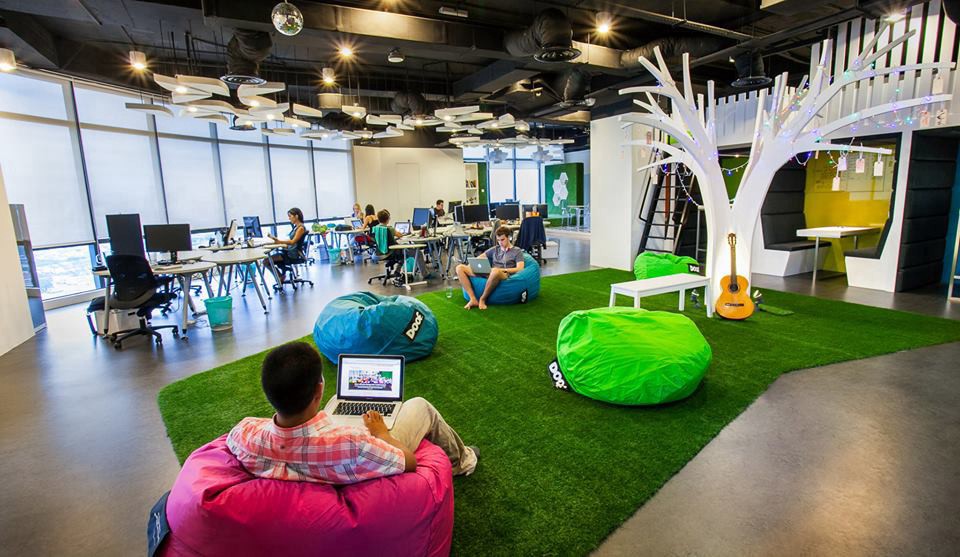
Wellness in the Workplace
Health impacts from excess of anything is always discovered later on… it takes time for the negative side of any activity to take its toll on the human body. Longer work hours, long exposure in front of millions of pixels, increased stress in the workplace and sitting for extended periods of time have all caught up with millions of humans that are part of the workforce.
It has resulted in many physical and mental issues in the last several decades. Increased suicide rates, obesity, spinal complications, and anxiety are just a few of the complications unhealthy work environment inflict on workers. Wellness at work has been and will continue to be a competitive advantage in recruiting younger generations of workers.

We Care about You
This has become a widely adopted core principle in company mission statements when referring to their employees. A special assurance that investments in the physical space and culture are being made to promote well being and happiness. The fact that our food is all organic and non-GMO or that we run on fully renewable energy to help protect your environment and planet. We’re the “good guys”. We care for the people that both build and consume our products. The implicit subtext is that the other guys do not. Overall, we are seeing a transition… incentives within the system are changing and we are finally seeing an attempt to create a win-win for all market participants.
Energy Draining Environment
The people you surround yourself with has major implications for what your believe, how you behave, and your worldview. Unfortunately, within the work environment, unless you’re part of management, you are not involved in recruiting and team decisions. You don’t determine who will be on your team and how much time you will be spending together. We have all experienced that “Debbie Downer” co-worker who brings 8 suitcases full of baggage to the office everyday. Rambling on about how their marriage isn’t working out, how the person in front of them in Starbucks put in an order for their entire office or how they can’t afford to buy the latest iPhone because their rent went up for the third month in a row.

As real as their challenges are, they are choosing to focus on them in a way that isn’t healthy for them and certainly isn’t healthy for co-workers. The counterexample is when we are overjoyed to get together with close friends and family. It’s not because they don’t have challenges of their own, but rather there is a sense of joy that comes with just being present with them — regardless of what else may be going on in your life. The energy that people bring around you can either drain you completely or fill you with bliss and restore your energy. When a molecule is positive (+), it wants to get rid of electrons to balance itself out… it’s looking to pass on energy to another molecule. The negative (-) molecule is looking to leech energy from other molecules. The positive molecule is happy to give off energy since it’s always in abundance while the negative molecule is always in a state of scarcity and needs to draw energy from others. I hope this analogy helps you better understand this phenomenon at work and in life.
So how are we fixing this problem in the workplace? Companies are not looking to address the personal problems of their workforce, but instead help them create an environment that fills people up, which inevitably has a positive impact on issues that people may be wrestling with outside of the office. Employers set aside time during the workday for recreational activities, games, positive social activities, rest and relaxation, food-drink-light conversation to support people and create positive connections. Once you create an environment that is fun and enjoyable, it raises the standard for everyone to contribute and sustain that mood. Noone wants to be that “buzz kill”. By creating a more positive work environment, employers are significantly improving the mental and physical health of all employees.
Physical Health
Lack of physical activity throughout the day like standing up, walking around…getting the blood pumping and circulating… can lead to health issues. If you are sedentary throughout the day that could lower your life expectancy. When you are stuck inside an office for the majority of your week, you don’t get sufficient natural light from the sun. Vitamin D deficiency makes it difficult to sleep and concentrate when you are awake. There is a domino effect at play in many cases — overworking leads to sleep deprivation, sleeplessness can lead to erratic eating patterns. Some will feel the need to skip a meal in order to get more rest. Skipping breakfast regularly, as an example, has shown to increase body stress over time. And the dominoes that are falling in this case, is your physical, mental, and emotional health.
Studies have proven that staring at a computer screen all day will strain your vision and lead to permanent damage. The combination of both artificial light and consistent viewing of farsighted perspective interactions with the monitor is leading to perspective changes in our sight, causing us to have less visual acuity. Staying seated for more than 90 minutes at a time causes chronic posture problems… and the lack of movement causes obesity and muscle stress.

Companies are creating initiatives to promote more physical activity at work. From group yoga, standing desks, open offices to mud runs and outdoor game competitions. They are making it a priority for employees to participate in activities that get them moving. They understand that this type of investment in employees leads to healthier workers and better business results.
Relationships
Earlier we shared an example of co-workers that carry baggage into work and how business’ are curating healthier, happier environments in which that kind of behavior is the exception not the rule. From vacation days to maternity leave, employers are investing in their workforce maintaining good personal connections in and outside of the office. From Part 1, work-life balance is very important for all. With work and intention, management and employee relationships are improving. CEO’s and other senior executives are prioritizing workplace culture. The net result of all of this corporate shift in caring about and investing in healthy workers, workplace, and culture is that the experience of work is getting better FOR ALL, including employees and managers.
Democratization of Brand Influence (Part 3) ->





